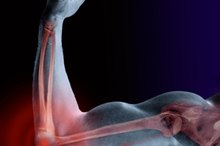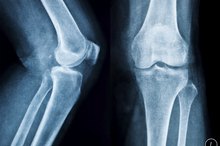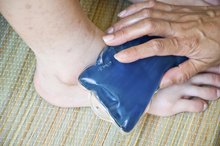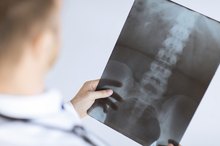Bone Spurs in Children
Bone spurs in children are excess bone that develops along the side or edge of a bone. The clinical name for this extra bone growth is osteophytes. Bone spurs can form along almost any bone, but they are particularly prone to grow at joints. As a result, it is not uncommon to find bone spurs along the spine, since this is the part of the body with the highest number of joints. Very often, people with bone spurs that developed when they were children do not know that the spurs exist until they are well into adulthood.
Symptoms
According to the Mayo Clinic, many times bone spurs have no pain or symptoms at all, particularly when they are on the bones of children. However, some bone spurs are painful and can limit range of motion as a person grows older and his bones solidify. Bone spurs in the knee may limit your ability to fully extend the knee and bend it, making walking difficult. Bone spurs in the neck or spine can be painful and cause numbness in arms and legs.
Causes
How Can I Get Rid of a Bone Spur on My Knee?
Learn More
WebMD indicates that bone spurs develop for a number of different reasons. In some cases, they develop due to the bones trying to repair themselves due to stress, rubbing or pressure that occurs over time. Bone spurs in children often develop as a result of a bone being stressed due to being broken or fractured. Other reasons for bone spurs to develop include aging and tight ligaments. As the body breaks down with aging and the cartilage breaks down, spurs develop along the sharp edges of bone in the joints.
Diagnosis
Doctors diagnose bone spurs with a variety of different tests. According to the Mayo Clinic, these tests include X-rays, computerized tomography (CT) scans and magnetic resonance imaging (MRI) scans. All of these tests allow the doctor to look inside the body and see the bone structure and determine if the pain being experienced is due to a bone spur. This is particularly important in determining the cause of joint pain.
Treatments
Signs of a Bone Spur in Elbow
Learn More
According to WebMD, there are numerous treatments for bone spurs. Often, doctors will suggest weight loss as a method to take pressure off of bone spurs that occur in the feet or on the heels. Other treatments include stretching and strengthening ligaments through physical therapy and exercise. In some cases, doctors will prescribe NSAIDs to help with pain and inflammation that may occur with bone spurs. If medication does not help with pain, a doctor may recommend that corticosteroids be injected at the site of the bone spur as an alternative treatment. Finally, surgery may be required to remove the spur from the bone.
Complications
Although bone spurs are often benign and do not cause more than minimal discomfort, occasionally complications arise. According to the Mayo Clinic, if a bone spur breaks off from the bone, it may float in the body and become lodged in the closest adjacent joint, resulting in painful complications in being able to move the joint or extend it. If this occurs, the bone spur will need to be surgically removed to prevent further problems.
Related Articles
References








